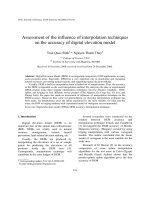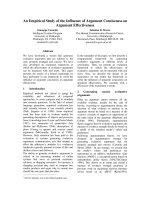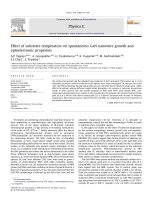- Trang chủ >>
- Khoa Học Tự Nhiên >>
- Vật lý
influence of polymerization temperature on nh3
Bạn đang xem bản rút gọn của tài liệu. Xem và tải ngay bản đầy đủ của tài liệu tại đây (639.66 KB, 8 trang )
A
vailable online at www.sciencedirect.com
Sensors and Actuators B 129 (2008) 319–326
Influence of polymerization temperature on NH
3
response of PANI/TiO
2
thin film gas sensor
Huiling Tai, Yadong Jiang
∗
, Guangzhong Xie, Junsheng Yu
∗
,
Xuan Chen, Zhihua Ying
State Key Laboratory of Electronic Thin Films and Integrated Devices, School of Optoelectronic Information,
University of Electronic Science and Technology of China (UESTC), Chengdu 610054, PR China
Received 23 May 2007; received in revised form 5 August 2007; accepted 7 August 2007
Available online 10 August 2007
Abstract
Polyaniline/titanium dioxide (PANI/TiO
2
) nanocomposite thin films were processed on a silicon substrate with gold interdigital electrodes by an
in-situ self-assembly approach for NH
3
gas-sensing application, and the effect of polymerization temperature on the gas response of the PANI/TiO
2
thin film gas sensor was investigated. The results showed that the PANI/TiO
2
thin film prepared at 10
◦
C was superior to those prepared at other
temperatures in terms of response properties, which also exhibited good reproducibility, selectivity and long-term stability. UV–vis absorption and
surface morphology characterization of the nanocomposite thin films were performed to explain these different gas-sensing properties. The sensing
mechanism was also discussed.
© 2007 Elsevier B.V. All rights reserved.
Keywords: PANI/TiO
2
; Nanocomposite thin film; NH
3
; Polymerization temperature; Gas sensor
1. Introduction
The importance of qualitative and quantitative analysis
of chemical substances has been well understood for the
sustainable development of human being and its habitation envi-
ronment, and a large volume of research has been focused on
the development and fabrication of gas sensors for detection of
gaseous chemicals. Choice of suitable sensing materials along
with efficient microelectronics for the detection system is the
key step in such efforts [1]. At present, the nanocomposite
of conducting polymer/metal oxide for gas-sensing application
has attracted a lot of attention, as it has been proved that the
hybridization could synergize or complement the sensitive prop-
erties of pure organic or inorganic gas-sensing material [2–4].
Among various conducting polymers, polyaniline (PANI)
was found to be a better choice for gas-sensing material due to
its good environmental and chemical stability, ease of synthesis,
∗
Corresponding authors. Tel.: +86 28 83207157; fax: +86 28 83206123.
E-mail addresses: (Y. Jiang),
(J. Yu).
inexpensive monomer as well as higher sensitivity, reversible
response and shorter response time compared with polypyr-
role [1,5]. Therefore, recent different gas sensors based on
PANI nanocomposites combined with various metal oxides
have been the subject of considerable interest, i.e., PANI/SnO
2
[2,6], PANI/TiO
2
[6,7], PANI/MoO
3
[8], PANI/WO
3
[9], and
PANI/In
2
O
3
[3], etc. On the other hand, as a kind of inorganic
gas sensitive material, TiO
2
is a typical n-type semiconductor
and has received particular attention due to its good stability
and environmental-friendliness [4]. Therefore, it is hopeful to
obtain novel materials with complementary behaviors between
PANI and TiO
2
. Various PANI/TiO
2
nanocomposites have been
prepared by using chemical polymerization or electrochemical
polymerization of aniline in the presence of nano-colloidal TiO
2
.
Moreover, our group also reported a PANI/TiO
2
nanocompos-
ite thin film gas sensor prepared at room temperature [10].It
has been revealed that the PANI/TiO
2
nanocomposite thin film
gas sensor exhibited higher response values, faster response and
recover rates to NH
3
than those of a pure PANI thin film sen-
sor fabricated under the identical conditions. However, it was
also found that the response time and long-term stability of the
prepared PANI/TiO
2
gas-sensor was not good enough for prac-
0925-4005/$ – see front matter © 2007 Elsevier B.V. All rights reserved.
doi:10.1016/j.snb.2007.08.013
320 H. Tai et al. / Sensors and Actuators B 129 (2008) 319–326
tical application. In order to improve the performance of the
gas sensor based on the PANI/TiO
2
nanocomposite thin film
and develop a usable NH
3
gas sensor, the polymerization tem-
perature was systematically optimized for film processing in
this work, and the nanocomposites and films were characterized
by FTIR, UV–vis spectroscopy and scanning electron micro-
copy (SEM). The concentration and temperature characteristics
of the PANI/TiO
2
thin films as well as the reproducibility,
selectivity and long-term stability of gas sensors were also
investigated.
2. Experimental
2.1. Materials
Polydialyldimethyldiammonium chloride (PDDA), poly-
(sodium-p-styrenesulfonate) (PSS), aniline and colloidal TiO
2
(particle size < 40 nm) were all obtained from Sigma–Aldrich
Co. Ammonium persulfate ((NH
4
)
2
S
2
O
8
, APS) and hydrochlo-
ric acid (HCl) were purchased from Chengdu Kelong Chemical
Reagent Co. All the chemical and reagents were used as received
without further purification.
Fig. 1. FTIR spectra of pure PANI and PANI/TiO
2
composite.
Fig. 2. UV–vis absorption spectra of a PANI thin film prepared at 20
◦
C and
PANI/TiO
2
nanocomposite thin films prepared at different polymerization tem-
peratures.
2.2. Fabrication of PANI/TiO
2
nanocomposite thin films
PANI/TiO
2
nanocomposite thin films were synthesized by in-
situ self-assembly technique in the presence of colloidal TiO
2
with a dip-coater (KSV Co., Finland). A typical fabrication pro-
cess for PANI/TiO
2
nanocomposite thin film was as follows:
0.1 g PSS was dissolved in 50 mL of deionized (DI) water, and
adjusted pH to 1 using a hydrochloric acid solution. A positively
charged surface was created via the deposition of a 1.0% PDDA
aqueous solution for 15 min, and then the positively charged
substrate was dipped into the PSS solution for 15 min to obtain
a negatively charged surface. Later, the PSS-coated substrate
was washed with DI water and dried by a nitrogen blow. The
PSS-coated substrate was suitable to fabricate PANI/TiO
2
thin
films, where simultaneous polymerization of aniline monomer
and oxidation of PANI molecules occurred. The active solu-
tion for PANI/TiO
2
nanocomposite material contained colloidal
TiO
2
, aniline monomer and HCl followed by the addition of an
oxidizing agent (APS). The optimum film of PANI/TiO
2
was
achieved with a solution containing 0.1 mL of aniline, 10 mL
of the sonicated colloidal TiO
2
(0.1 wt.%), 20 mL of 2.0 M HCl
and 10 mL of a hydrochloride solution of APS with an equal
molar ratio to aniline. The resulting mixture was kept still for
5 min after the addition of APS and then filtered. Such a fil-
tered solution was used for the deposition of PANI/TiO
2
film.
The PDDA/PSS substrate was removed from the reaction mix-
ture after 20 min and then immersed into a 1.0 M HCl solution
for 5 min and dried in air. The polymerization of PANI/TiO
2
nanocomposite was processed under various temperatures, i.e.,
−10, 0, 10, 20 and 30
◦
C. A PANI thin film was also fabricated
without TiO
2
at 20
◦
C.
Table 1
Maximum absorbancewavelengths of PANI/TiO
2
thin filmsprepared atdifferent
polymerization temperature
Polymerization
temperature (
◦
C)
λ
1
(nm) λ
2
(nm) λ
3
(nm) λ
4
(nm)
−10 857 425 366 399
0 874 423 363 390
10 859 415 369 378
20 865 418 360 371
30 840 423 330 359
Table 2
Response time (T
1
) and recovery time (T
2
) of sensors based on PANI/TiO
2
thin
films prepared at 0, 10 and 20
◦
C when exposed to NH
3
of various concentrations
at room temperature
Concentration
of NH
3
(ppm)
0
◦
C10
◦
C20
◦
C
T
1
T
2
T
1
T
2
T
1
T
2
23 6 70 2 60 2 61
47 8 68 3 56 2 46
70 6 44 2 32 3 29
94 9 50 2 25 7 19
117 6 33 2 23 5 20
141 6 25 2 19 7 21
H. Tai et al. / Sensors and Actuators B 129 (2008) 319–326 321
2.3. Characterization of films
FTIR spectra of pure PANI and PANI/TiO
2
nanocomposite
samples palletized with KBr were performed by a NICOLET
MX-1E Fourier transformed spectrometer. The UV–vis absorp-
tion spectra of pure PANI and PANI/TiO
2
nanocomposite thin
films were recorded on a Shimadzu UV1700 spectrometer
using an uncoated glass as the reference. The surface mor-
phology was assessed with a JSM-5900LV scanning electronic
microscope.
3. Results and discussion
3.1. FTIR spectra of pure PANI and PANI/TiO
2
nanocomposites
The resulting PANI and PANI/TiO
2
solutions described in
Section 2.2 were left still at 20
◦
C for another 6 h. The products
were filtered and washed with 2.0 M HCl and DI water each for
three times in turn. The products were dried at 80
◦
C for 12 h
under vacuum. The FTIR spectra of pure PANI and PANI/TiO
2
Fig. 3. Dynamic responses of the sensors based on PANI/TiO
2
nanocomposite thin films prepared at (a) −10
◦
C, (b) 0
◦
C, (c) 10
◦
C, (d) 20
◦
C, and (e) 30
◦
CtoNH
3
at room temperature.
322 H. Tai et al. / Sensors and Actuators B 129 (2008) 319–326
Fig. 4. Responses of the nanocomposite sensors prepared at different polymer-
ization temperature to NH
3
of different concentration.
nanocomposites are shown in Fig. 1. The main characteristic
peaks of pure PANI are assigned as follows: the bands at 1565
and 1488 cm
−1
are attributed to C N and C
C stretching mode
of vibration for the quinonoid and benzenoid units of PANI;
1291 and 1133 cm
−1
are the stretching peak of C N and C N,
respectively; the peak at 797 cm
−1
is assigned to C H bend-
ing vibration out of the plane of the para-disubstituted benzene
rings [2,11–13]. For PANI/TiO
2
nanocomposite, the IR spec-
trum is almost identical to that of pure PANI, but all bands shift
slightly, indicating that some interaction exists between PANI
and nano-TiO
2
. In addition, the absorption band at 1408 cm
−1
can be assigned to the in-plane bending vibration of O H on the
surface of TiO
2
[14].
3.2. UV–vis absorption spectra of PANI and PANI/TiO
2
nanocomposite thin films
Fig. 2 depicts the UV–vis absorption spectra of PANI and
PANI/TiO
2
thin films deposited on the PDDA/PSS glass sub-
strate under different polymerization temperatures. It shows that
Fig. 5. Schematic energy-band diagram for PANI/TiO
2
nanocomposite.
three characteristic bands of the doped PANI thin film prepared
at 20
◦
C appear at about 361, 402 and 859 nm, which can be
attributed to the –*, polaron–* and –polaron transitions,
respectively [6,7,11]. It can be noted that the characteristic peaks
of the doped PANI all appear in the PANI/TiO
2
nanocompos-
ite thin films, but there are some shifts compared with pure
PANI, and some new peaks are observed in the PANI/TiO
2
nanocomposite thin films shown in Table 1, which indicates
that encapsulation of nano-TiO
2
particles has the effect on the
doping of conducting PANI, while this effect should owe to an
interaction at the interface of PANI and nano-TiO
2
particles [11].
Also it could be obviously observed that the absorption inten-
sity increases with decreasing the temperature, i.e., the thickness
of the in-situ self-assembly deposited PANI/TiO
2
thin films
increases with decreasing the temperature, which is consistent
with the previously reported results [15].
3.3. Gas-sensing properties measurements
NH
3
gas sensors were designed and fabricated to operate as
a resistive element. Gold sputtered interdigital electrodes were
fabricated on a 5 mm × 8 mm silicon substrate to form a trans-
ducer, which were directly used to measure the resistance change
of the sensitive PANI/TiO
2
nanocomposite thin film layer when
exposed to NH
3
gas of different concentrations.
The device was put into a test box (320 mL), and a certain
amount of NH
3
gas was injected into the test chamber after the
resistance reached a steady value in clean air. Gas exposure time
was ca. 150 s for each pulse of NH
3
gas and the chamber was
purged with clean air for ca. 200 s after each pulse to allow the
surface of the sensitive film to regain atmospheric condition.
A Keithley 2700 data acquisition system was used to measure
the resistance variation of the sensors. The measurement was
processed at room temperature.
Dynamic responses of the sensors based on PANI/TiO
2
thin
films fabricated under different polymerization temperatures to
NH
3
are shown in Fig. 3a–e. It can be seen that the resistance of
all sensors increases dramatically after exposed to NH
3
gas. It is
also observed that fast resistance increases were followed by a
decrease of resistance, which is most obvious for the thin films
Fig. 6. Gas responses of the nanocomposite sensor prepared via polymerization
at 10
◦
C to 23 ppm NH
3
, 23 ppm CO and 500 ppm H
2
.
H. Tai et al. / Sensors and Actuators B 129 (2008) 319–326 323
Fig. 7. Sensing reproducibility of the nanocomposite sensor prepared via poly-
merization at 10
◦
C to 23 ppm NH
3
at room temperature.
prepared at −10 and 30
◦
C, indicating that either more than one
type of reaction sites are available or that a number of different
reactions are possible [16]. It is believed that the porous structure
of thin films leads to the predominance of surface phenomena
over the bulk material phenomena, and therefore the resistance
increases significantly with time initially when PANI nanocom-
posite thin films contact with NH
3
by gas injection, which may
be due to the surface adsorption effect, and the chemisorptions
leads to the formation of ammonium. However, the interaction
process between the thin film and the adsorbed gas is a dynami-
cal process. Thus, when the thin film is exposed to NH
3
gas, the
adsorption and desorption processes will simultaneously occur,
and the thinner the films, the quicker the gas desorption. Then,
the resistance attains a stable value when dynamic equilibrium
is attained. However, further interaction mechanism study needs
to be carried out to verify this speculation. Additionally, the sen-
sors based on PANI/TiO
2
thin films prepared at −10 and 30
◦
C
exhibit incomplete reproducibility, which is especially serious
for the thin films fabricated at −10
◦
C, as shown in Fig. 3a,
indicating a low reproducibility to NH
3
.
The gas response is defined as (R
gas
− R
air
)/R
air
, where R
air
is the resistance of sensor in air and R
gas
is the steady resistance
of sensor in the presence of a tested gas. The response values of
all the samples are plotted as a function of NH
3
concentration in
Fig. 4, indicating a highly linear characteristic and the highest
Fig. 8. Long-term variation in resistance of the nanocomposite sensors prepared
via polymerization at room temperature (25
◦
C) and 10
◦
C.
Fig. 9. Response of the sensor prepared via polymerization at 10
◦
CtoNH
3
of
different concentrations after 0, 6, and 30 days.
response value for the sensor composed of the PANI/TiO
2
thin
film prepared at 10
◦
C.
We define the response and recovery time as the time required
to reach 90% total resistance change. As the sensors based on
PANI/TiO
2
thin films prepared at −10 and 30
◦
C exhibited slow
reaction equilibrium and low reproducibility to NH
3
, only the
characteristic times of other three sensors in the case of various
NH
3
concentrations are presented in Table 2. It shows that the
response time (T
1
) is almost independent on the gas concentra-
tion, and a fast response time of 2 s can be observed to different
NH
3
concentrations for the PANI/TiO
2
thin film prepared at
10
◦
C; the recovery time (T
2
), however, decreases with increas-
ing the gas concentration. The reason to cause this phenomenon
is that an increase in concentration leads to an increased amount
of chemisorbed NH
3
, which in turn enhances the desorption rate
and sensing site renewal [1].
Kukla et al. [17] proposed that the mechanism to explain
the sensitivity and reversibility of PANI layers to NH
3
was a
deprotonation–reprotonation process, and the resistance showed
an exponential growth with an increase in NH
3
concentration.
However, it can be seen from Fig. 3a–e that the resistance of the
Fig. 10. Response to 23 ppm NH
3
of the sensor prepared via polymerization at
10
◦
C as a function of temperature.
324 H. Tai et al. / Sensors and Actuators B 129 (2008) 319–326
PANI/TiO
2
nanocomposite thin films grew instantaneously and
did not follow the resistance change trend observed with PANI
sensors. We have postulated that PANI and TiO
2
form a p–n
junction and the inter-particle electron transition from TiO
2
to
PANI causes the reduction of the activation energy and enthalpy
of physisorption for NH
3
gas [10]. Fig. 5 exhibits a schematic
energy diagram to further illuminate the NH
3
gas sensing mech-
anism of PANI/TiO
2
nanocomposite thin films [14,18], where
HOMO presents the highest occupied molecular orbital, and
LUMO is the lowest unoccupied molecular orbital. Li et al. [14]
showed that charge separation was enhanced due to well energy
bandgap matching between the conduction band of TiO
2
and
the LUMO level of PANI for charge transfer. Therefore, it is
also believed that such enhancement promotes NH
3
gas-sensing
ability of the PANI/TiO
2
nanocomposite.
Generally, a single chemical sensor has cross-sensitivity,
which hinders it from practical application. Herein we measured
the responses of the sensor composed of the thin film prepared at
10
◦
C to 23 ppm CO and 500 ppm H
2
, and the results are shown
in Fig. 6. It can be seen that there is a distinct difference in gas
responses to the tested gases, and the sensor showed very weak
responses to CO and H
2
. Based on this observation, it is believed
that the sensor exhibits high selectivity to NH
3
. In addition, the
response of this sensor was monitored for the repeated expo-
sure and removal of 23 ppm NH
3
up to three cycles, as shown
in Fig. 7, indicating high reproducibility and reversibility.
Fig. 11. SEM images of PANI/TiO
2
nanocomposite thin films prepared at (a) −10
◦
C, (b) 0
◦
C, (c) 10
◦
C, (d) 20
◦
C, (e) 30
◦
C.
H. Tai et al. / Sensors and Actuators B 129 (2008) 319–326 325
Our earlier work [10] showed that the resistance of the sen-
sor prepared via polymerization at room temperature (25
◦
C)
increased greatly when the sample was stored in air, whereas
the response of the sensor to NH
3
decreased by a factor of 2–3
during 30 days. Therefore, the lack of long-term stability of
the fabricated sensor was of concern. The resistance changes
of the sensors prepared via polymerization at room tempera-
ture and 10
◦
C are shown in Fig. 8. It can be observed that the
latter exhibits higher long-term stability in resistance than the
former. The excellent stability of the latter was also confirmed
by testing its response after a 6- and 30-day period, as shown in
Fig. 9, indicating that the response values do not exhibit signifi-
cant change. Meanwhile, it was found that the response/recovery
time also kept stable.
3.4. Temperature characteristic
It is well known that humidity and temperature have a sig-
nificant effect on the operation of gas sensors. The effect of
humidity on the performance of PANI/TiO
2
nanocomposite thin
film sensors was investigated in our earlier work [10], and then
the temperature dependence of response was studied here. The
response to 23 ppm NH
3
of the sensor based on the thin film
fabricated at 10
◦
C is shown as a function of temperature in
Fig. 10. It is observed that the response decreases with increas-
ing temperature, which is in good agreement with the results of
the reported NH
3
gas sensor based on PANI [17,19]. This indi-
cates that the adsorption–desorption equilibrium shifts in the
desorption direction with increasing temperature [17]. Accord-
ingly, the prepared gas sensor is preferred to be operated at room
temperature.
3.5. Surface morphology of PANI/TiO
2
thin films
The effect of morphology of sensitive films such as grain size,
structural formation, surface-to-volume ratio and film thickness
on the gas sensitivity, was well recognized [3]. Therefore, the
SEM images of all the PANI/TiO
2
thin films prepared under
different polymerization temperatures are shown in Fig. 11.It
can be seen that all the films have a very porous structure, inter-
connected network of fibers and high surface area. It has been
pointed out that such structure contributes to a rapid diffusion
of dopants into the film [10]. However, as shown in Fig. 11,
the PANI/TiO
2
thin film prepared at −10
◦
C exhibits a two-
dimensional slab surface including some disorderly fibers, and
the PANI/TiO
2
thin film prepared at 0
◦
C has a rough surface
and consists of coral-like particulates. It is considered that such
kind of structure affects the diffusion of gas into and out of
the entire bulk of the fibrous film. In contrast, there are almost
no granular particulates in the nanocomposite films prepared
at 10, 20 and 30
◦
C. The difference is that the film fabricated
at 10
◦
C has many uniform cylinders and presents a compact
three-dimensional surface, whereas the films fabricated at 20
and 30
◦
C exhibit a relative sparse network structure. All the
above factors are in accordance with the observation that the
sensor consisted of the thin film prepared at 10
◦
C has a faster
and higher response to NH
3
gas.
Li et al. [20] proposed that during the synthesis of PANI
its aggregation was triggered by heterogeneous nucleation, and
the nucleation behavior of PANI is strongly dependent on the
polymerization rate determined by reaction temperature. As the
formation of new embryonic nuclei is much faster at high tem-
perature, it is more likely that these embryonic nuclei evolve
to create homogeneous nuclei before they can diffuse into
heterogeneous nucleation sites to nucleate. Thus, more PANI
molecules will precipitate via homogeneous nucleation at higher
temperature, and the possibility of heterogeneous nucleation will
be decreased. This is also in agreement with the observation
that the thickness of in-situ self-assembly films increases with
decreasing temperature, as shown in Fig. 2. Therefore, the films
prepared at high temperatures have better uniformity than those
prepared at −10 and 0
◦
C.
4. Conclusions
The NH
3
sensing capability of PANI/TiO
2
thin film sensors
was investigated and the polymerization temperature was opti-
mized. The PANI/TiO
2
thin film prepared at 10
◦
C exhibited
stable, reproducible and reversible resistance change in the pres-
ence of NH
3
in the range of 23–141 ppm. The response time was
kept 2 s, and the recovery rate was also very fast in the range
of 20–60 s depending on the NH
3
concentration. The sensor
also had high selectivity and long-term stability. The difference
of gas-sensing property among sensors prepared under differ-
ent polymerization temperatures was characterized with UV–vis
spectra and SEM, and a simple schematic energy diagram was
presented to illuminate the gas sensing mechanism.
The in-situ self-assembly approach proposed in this work is
easy-processing and feasible, which is also prone to produce
PANI/TiO
2
thin film in large scale. In addition, the prepared
PANI/TiO
2
gas sensor is preferred to be operated at room tem-
perature, which has potential to develop the practical NH
3
gas
sensor at low cost.
Acknowledgements
This work was supported by National Science Foundation of
China via grant no. 60425101 and Program for New Century
Excellent Talents in University via grant no. NCET-06-0812.
References
[1] G.K. Prasad, T.P. Radhakrishnan, D. Sravan Kumar, M. Ghanashyam
Krishna, Ammonia sensing characteristics of thin film based on polyelec-
trolyte templated polyaniline, Sens. Actuat. B 106 (2005) 626–631.
[2] L. Geng, Y. Zhao, X. Huang, S. Wang, S. Zhang, S. Wu, Characterization
and gas sensitivity study of polyaniline SnO
2
hybrid material prepared by
hydrothermal route, Sens. Actuat. B 120 (2007) 568–572.
[3] A.Z. Sadek, W. Wlodarski, K. Shin, R. Bkaner, K. Kalantar-Zadeh, A
layered surface acoustic wave gas sensor based on a polyaniline/In
2
O
3
nanofibre composite, Nanotechnology 17 (2006) 4488–4492.
[4] X. Zhang, G. Yan, H. Ding, Y. Shan, Fabrication and photovoltaic proper-
ties of self-assembled sulfonated polyaniline/TiO
2
nanocomposite ultrathin
films, Mater. Chem. Phys. 102 (2007) 249–254.
[5] N. Densakulprasert, L. Wannatong, D. Chotpattananont, P. Hiamtup, A.
Sirivat, J. Schwank, Electrical conductivity of polyaniline/zeolite compos-
326 H. Tai et al. / Sensors and Actuators B 129 (2008) 319–326
ites and synergetic interaction with CO, Mater. Sci. Eng. B 117 (2005)
276–282.
[6] M.K. Ram, O. Yavuz, V. Lahsangah, M. Aldissi, CO gas sensing from
ultrathin nano-composite conducting polymer film, Sens. Actuat. B 106
(2005) 750–757.
[7] X. Ma, M. Wang, G. Li, H. Chen, R. Bai, Preparation of polyaniline-TiO
2
composite film with in situ polymerization approach and its gas-sensitivity
at room temperature, Mater. Chem. Phys. 98 (2006) 241–247.
[8] J. Wang, I. Matsubara, N. Murayama, S. Woosuck, N. Izu, The preparation
of polyaniline intercalated MoO
3
thin film and its sensitivity to volatile
organic compounds, Thin Solid Films 514 (2006) 329–333.
[9] N. Parvatikar, S. Jain, S. Khasim, M. Revansiddappa, S.V. Bhoraskar,
M.V.N. Ambika Prasad, Electrical and humidity sensing properties of
polyaniline/WO
3
composites, Sens. Actuat. B 114 (2006) 599–603.
[10] H. Tai, Y. Jiang, G. Xie, J. Yu, X. Chen, Fabrication and gas sensitivity of
polyaniline-titanium dioxide nanocomposite thin film, Sens. Actuat. B 125
(2007) 644–650.
[11] X. Li, G. Wang, X. Li, D. Lu, Surface properties of polyaniline/nano-TiO
2
composites, Appl. Surf. Sci. 229 (2004) 395–401.
[12] A.G. Yavuz, A.E. G¨ok, Preparation of TiO
2
/PANI composites in the pres-
ence of surfactants and investigation of electrical properties, Synth. Met.
157 (2007) 235–242.
[13] K. Dutta, S.K. De, Optical and nonlinear electrical properties of SnO
2
-
polyaniline nanocomposites, Mater. Lett. 61 (2007) 4967–4971.
[14] J. Li, L. Zhu, Y. Wu, Y. Harima, A. Zhang, H. Tang, Hybrid composites
of conductive polyaniline and nanocrystalline titanium oxide prepared via
self-assembling and graft polymerization, Polymer 47 (2006) 7361–7367.
[15] J. Stejskal, I. Sapurina, J. Prokes, J. Zemek, In situ polymerized polyaniline
films, Synth. Met. 105 (1999) 195–202.
[16] A.Z. Sadek, W. Wlodarski, K. Kalantar-Zadeh, C. Baker, R.B. Kaner,
Doped and dedoped polyaniline nanofiber based conductometric hydrogen
gas sensors, Sens. Actuat. A: Phys. 139 (2007) 53–57.
[17] A.L. Kukla, Y.M. Shirshov, S.A. Piletsky, Ammonia sensors based on
sensitive polyaniline films, Sens. Actuat. B 37 (1996) 135–140.
[18] M.K. Ram, O. Yavuz, M. Aldissi, NO
2
gas sensing based on ordered ultra-
thin films of conducting polymer and its nanocomposite, Synth. Met. 151
(2005) 77–84.
[19] M. Matsuguchi, A. Okamoto, Y. Sakai, Effect of humidity on NH
3
gas
sensitivity of polyaniline blend films, Sens. Actuat. B 94 (2003) 46–52.
[20] D. Li, R.B. Kaner, Shape and aggregation control of nanoparticles: not
shaken, not stirred, J. Am. Chem. Soc. 128 (2006) 968–975.
Biographies
Huiling Tai received her BS degree in the field of electronic materials and
components from UESTC in 2003. Currently she is a PhD candidate of School
of Optoelectronic Information at UESTC. Her major field of scientific interests
is conducting polymer and its composite for gas sensor application.
Yadong Jiang graduated from Department of Material Science & Engineering
at UESTC with a BS degree in 1986. Then he got his MS degree and PhD
degree in 1989 and 2001, respectively, from that department at UESTC. He is
Professor and Dean of School of Optoelectronic Information at UESTC. His
major research interests include optoelectronic material and devices, sensitive
materials and sensors.
Guangzhong Xie got his MS degree in Physics from Sichuan University. He
is the Associate Professor of School of Optoelectronic Information at UESTC
since 2001. His research interests are sensitive material and sensors.
Junsheng Yu got his PhD degree from Graduate School of Bio-Applications &
System Engineering at Tokyo University of Agriculture and Technology in 2001.
Currently he is Professor of School of Optoelectronic Information at UESTC.
His research field is organic optoelectronic materials and devices.
Xuan Chen received herBS degree inchemistry fromUESTC in 2005. Currently
she is a MS student of School of Optoelectronic Information at UESTC. Her
major is polymer science for gas sensors.
Zhihua Ying received her BS degree in 2002 and MS degree in 2005 from
UESTC. She is in study for her PhD degree. Her research interests are sensitive
materials and sensors.









